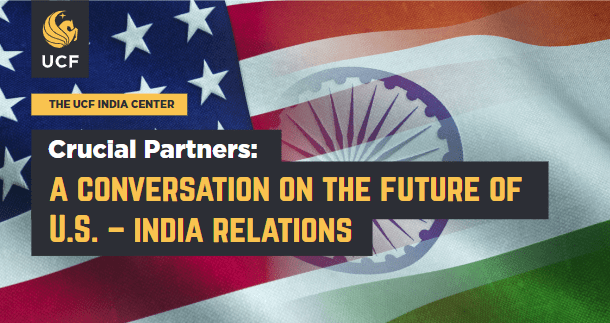Future of U.S. and India Relations Focus of Recent Talk

BY: KASSIDY MENK
The India Center hosted Milan Vaishnav, Ph.D., director and senior fellow of the South Asia Program at the Carnegie Endowment for International Peace, in a virtual discussion titled “Crucial Partners: The Future of U.S. – India Relations” on October 15, 2021. Nikola Mirilovic, Ph.D., associate professor in UCF’s School of Politics, Security, and International Affairs and a faculty affiliate of the India Center, moderated the presentation.
The United States started to form a strategic partnership with India in the late 1990s and early 2000s after the fall of the USSR. Vaishnav commented that this was due in part to politicians’ beliefs that investing in India would be best for the future of the U.S. With a rapidly growing population, India is a “democratic countervailing force” with the ability to successfully balance competition from China. This idea prevailed in the recent Quad Leaders’ Summit held this past September in Washington, D.C. The meeting of the leaders of Australia, Japan, the United States and India sent a strong message to other nations, and specifically to China, about India’s power in the Indo-Pacific region and their intent to maintain the existing international order.
As U.S.-India relations have grown stronger in the past 20 years, the U.S. has also seen growth in the number of Indian immigrants. Vaishnav commented that the Indian American community has consistently been active in public policy and in community political organizations, and are prized campaign contributors. This past April, when India was hit with a strong second wave of COVID-19 cases, the U.S. government was initially slow to respond with aid. Vaishnav believes the activism of the diaspora groups was a key factor in hastening the response of the U.S. government. However, Indian Americans constitute a heterogenous group. Vaishnav explained how the Indian American community has the same generational and educational differences as other voting groups. He highlighted how the younger generations are generally much more critical of Prime Minister Narendra Modi and more openly express their concerns.
Religious polarization is not the only issue in India right now. Vaishnav unpacked the “3 Pillars of Concern” that he believes threaten the U.S. and India’s commitment to shared values. These pillars are the expansion of the Hindu majoritarianism, the concentration of executive power and the decay of independent institutions and the curbing of free expression and dissent. Vaishnav believes U.S. rhetoric has begun to shift to address these concerns as a shared challenge. Rather than pushing India aside, the U.S. is constantly bringing India to the forefront of major global issues including trade, climate change and the current global pandemic. By addressing concerns as a joint effort, India is acknowledged as a leading world power that faces similar challenges as the U.S. After Vaishnav’s comments, the audience asked questions and engaged in discussion.
Watch the full discussion here or by viewing it below.

